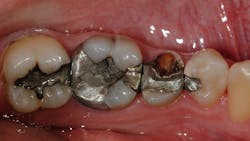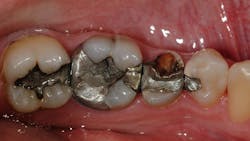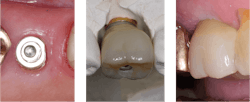Which is best: A 3-unit fixed prosthesis or an implant and crown?
Each month, Dr. Gordon Christensen answers a question from readers about everyday dentistry.
Q: Occasionally, I see a failing implant. It is a frustrating and expensive situation since the patient has spent over $3,000 for the implant, abutment, and crown. In the past, I thought implants would be a long-term replacement for teeth, but I am beginning to question that opinion. On the other hand, I see implants serving for many years without any sign of failure. What is the state of dental implant longevity?
A: I share your frustration. I have been placing and restoring root-form implants for about 35 years. Occasionally, I see an implant fail that I feel I have placed perfectly. I also see implants I could have placed better succeed for years. We must not be alone in these experiences, since our Practical Clinical Courses (PCC) two-day course on implant failure has been one of our most popular.
There are many potential reasons for implant failure. We know from significant well-known studies that about one-half of implants have peri-mucositis or peri-implantitis by about 10 years.1
Some implants with these conditions can be treated well at an early stage, but many must be removed. The conclusion is dental implant longevity is still being studied, and we do not know the exact cause of failure for a specific implant.
What is the importance of the last statement? When informed consent is being presented to a patient, they need to know the advantages and disadvantages of any treatment to allow them to make a legitimate decision on the treatment they want to have.
The following information compares the numerous aspects of replacing one missing tooth with an implant, abutment, and crown or a three-unit fixed prosthesis and discusses the factors that would give patients enough education to decide between the two options.
Restoration of one missing tooth with a fixed prosthesis (figure 1)
Advantages
Time needed: Treatment with a typical fixed prosthesis usually requires two appointments. Tooth preparation and temporization can be accomplished in about one hour. After the two to three weeks it takes for a technician to make the prosthesis, seating requires about a half hour.
Potential discomfort: With adequate anesthesia, neither of the two appointments should cause treatment discomfort. For a few posttreatment days, minor discomfort may be present because of soft-tissue irritation, and the patient may have mild cold sensitivity due to the unavoidable leaking of most provisional restorations.
After the prosthesis has been cemented, there may be minor tooth sensitivity caused by cold foods.
If the occlusion is not perfected at the seating appointment, there could be minor discomfort as the new restoration and involved teeth move into a position harmonious with the adjacent and opposing teeth.
Disadvantages
To make a bridge between the two abutment teeth, the teeth must be prepared by trimming with a rotary instrument, which usually removes most of the enamel.
Depending on the provisional fixed prosthesis quality, the temporary restoration can irritate the tongue or cheek during the two- or three-week period.
Infrequently, a provisional restoration comes off in service, causing tooth sensitivity.
Every dental restorative procedure has a finite life expectancy. Three-unit fixed prosthesis longevity has been studied by many researchers. The longevity of an adequately fabricated and seated prosthesis is about 20 years. However, I have seen some serve for 50 years or more.
Risks
When a tooth is cut down deeply enough to facilitate placement of a full crown, the procedure produces significant trauma to the tooth. A typical molar tooth has millions of dentinal tubules a few microns in diameter. Depending on how carefully the person making the tooth preparation cuts the tooth, it usually has no problem subsequently. However, some teeth are inadvertently traumatized to the extent that endodontic treatment is necessary. The dental literature has many contradictory studies on this topic. My own experience after placing thousands of crowns is that the occurrence of root canal treatment has been required by 5%–10% of crowns, depending on myriad factors.
Costs
There are several groups that estimate average dental fees in the US, and the fees vary markedly. Using the most recent (2022) ADA averages for estimating the cost of a three-unit fixed prosthesis, crowns and pontics are about $1,200 each or $3,600 for a three-unit fixed prosthesis. This cost could be higher if tooth buildup or post and core are needed. If the teeth adjacent to the single-tooth edentulous space need restoration, the cost of a three-unit fixed prosthesis restoring three teeth is about the same as a single--implant placement (figure 2).
Restoration of one missing tooth with an implant, abutment, and crown (figure 3)
Advantages
The teeth adjacent to the edentulous space do not need to be prepared.
Most implants have been shown to serve successfully for many years. Assuming an implant is not affected by peri-implantitis, the crown is usually the cause for failure—not the implant.
Disadvantages
Although implant placement does not require significant time, depending on bone quality and quantity, some implants require up to four to six months before they can be restored. During that time, some provisional restoration is usually needed.
There is minimal postoperative pain, but occasionally moderate pain is present.
Risks
Patients should be advised about the potential for nerve damage causing paresthesia or even anesthesia. Infection is possible, but infrequent. Both challenges occur only infrequently.
An integrated implant moves only a few microns in bone when fully integrated. Conversely, natural teeth move significantly in bone, which is related to their periodontal status and the occlusal forces placed on them. Often, contact areas open adjacent to implants since the teeth move and the implants do not. This unfortunate occurrence usually occurs on the mesial contact of posterior teeth due to the well-known mesial drift phenomena.
Early implant failure is infrequent, but, as stated previously, about 50% of implants have some type of periodontal disease by 10 years.
Costs
The costs vary significantly and may be different in your geographic area from those quoted here. A typical conventional-diameter implant placement costs about $2,200. An abutment placed on the implant costs about $800. A crown placed on the abutment costs about $1,200. The total of $4,200 could be more if bone grafting or other procedures are needed.
Discussion
After doing many of these procedures over several decades, I can candidly state that the fixed prosthesis procedure is faster, easier, slightly less expensive, and more predictable—and in the long-term, it may be better than the implant, abutment, and crown.
You may disagree with this conclusion, but the facts tend to support it. I always base treatment plans and treatment for any patient on what I would want if I were them, and I can make another candid statement based on research and my own experience: There is nothing as beautiful and serviceable as a human natural tooth, and strong natural teeth can certainly support a three-unit fixed prosthesis. However, I consider implants to be a fantastic service when there is not an alternative.
Summary
Root-form implants have been used for more than 35 years. They have changed much of what we as dentists do and have allowed procedures to be accomplished that were not possible in the past. When there is an opportunity to save a natural tooth, that opportunity should be taken, and when saving the tooth is hopeless, we are fortunate to have implants as a final alternative.
Editor's note: This article appeared in the October 2024 print edition of Dental Economics magazine. Dentists in North America are eligible for a complimentary print subscription. Sign up here.
Reference
- Derks J, Schaller D, Håkansson J, Wennström JL, Tomasi C, Berglundh T. Effectiveness of implant therapy analyzed in a Swedish population: prevalence of peri-implantitis. J Dent Res. 2016;95(1):43-49. doi:10.1177/0022034515608832
About the Author

Gordon J. Christensen, DDS, PhD, MSD
Gordon J. Christensen, DDS, PhD, MSD, is founder and CEO of Practical Clinical Courses and cofounder of Clinicians Report. His wife, Rella Christensen, PhD, is the cofounder. PCC is an international dental continuing education organization founded in 1981. Dr. Christensen is a practicing prosthodontist in Provo, Utah.



